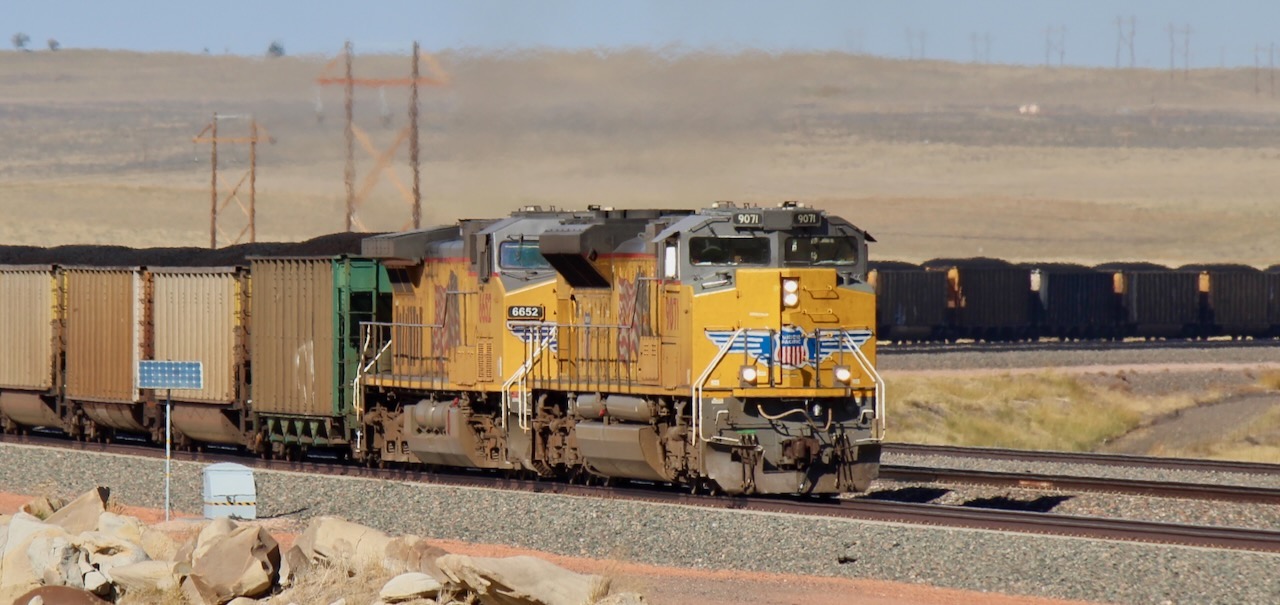
OMAHA Neb. — Union Pacific’s first-quarter profits rose despite flat revenue and lower freight volume.
“We are pleased to be able to report earnings growth in a tough environment,” CEO Jim Vena told investors and analysts on the railroad’s earnings call this morning.
Operating income rose 3%, to $2.3 billion, on flat revenue of $6 billion. Earnings per share grew 1%, to $2.69. The railroad’s operating ratio was 60.7%, a 1.4-point improvement compared to a year ago.
“It’s a great start to the year. I’m pleased with how the Union Pacific team is coming together to unlock what’s possible for our company,” Vena says. “But there’s a lot of work to do.”
UP upgraded its profitability outlook for the year thanks to service improvements, better network efficiency, and solid pricing. The railroad still expects muted volumes for the year due to an international intermodal contract loss to BNSF, lower coal demand, and soft economic conditions.
For the quarter, volume declined 1%. Excluding a 20% decline in coal, overall volume would have been up 2% for the quarter. “Coal is going to be a headwind. It is what it is. We need to outperform what our markets give us naturally to offset that impact,” Vena says. “And if we provide the service we sold our customers, I’m confident they’ll grow with us.”
Industrial products traffic was up 1% due to new petroleum volume and stronger demand for petrochemicals. Bulk traffic declined 5% largely due to lower coal volume amid high stockpiles and record low natural gas prices. Premium traffic — which includes intermodal and automotive — was up 1% due to strength in West Coast imports and higher auto shipments, including new business from Volkswagen and General Motors. Domestic intermodal volume remains soft.
UP has a positive outlook for grain products, petroleum and petrochemicals, and automotive, while expectations for coal, rock, and domestic intermodal are negative. The grain outlook is neutral, while international intermodal remains a question mark.
“Coal and domestic intermodal will put pressure on our volumes this year. But the team has taken action … I am confident that with our improved service product, we will continue to win new business and take trucks off the road,” says Kenny Rocker, executive vice president of marketing and sales.
The railroad’s key performance metrics improved for the quarter, with car-miles per day up 4%, the intermodal service performance index up 14 points to 95%, and the manifest/automotive service performance increasing 7 points to 87%.
“We exited 2023 with strong operational momentum across the board. And while weather quickly presented its challenges, the team rose to the task,” says Eric Gehringer, executive vice president of operations. “The speed with which our service product recovered is a testament to our strategy and the resiliency of our network. We continue to see meaningful year of year improvements in our metrics. This is a direct result of our steadfast focus on providing industry leading safety, service, and operational excellence.”
UP’s safety metrics improved during the quarter, including a 15% reduction in personal injuries and a 6% reduction in the derailment rate.
UP’s train crew staffing levels are 4% higher than last year, and the railroad has been able to eliminate the practice of using “borrow out” engineers and conductors at areas that were short of crews last year.
The increased train, engine, and yard staffing levels, which include conductor trainees, will enable UP to meet new scheduled work agreements and serve as a capacity buffer, Gehringer says.
UP executives were asked whether Ferromex has been able to handle increased volume this year and whether capacity improvements may be in order. The Eagle Pass, Texas, gateway has gained importance due to the shift of BNSF Railway’s J.B. Hunt intermodal traffic to Ferromex from its prior routing via the Laredo gateway and Canadian Pacific Kansas City. Eagle Pass also is handling increased volume from the Falcon Premium service UP and Ferromex run in conjunction with Canadian National.
Vena said that UP is working closely with Ferromex. “We know where the points of concern are. FXE has done a good job of identifying what they have to do and I think they run a good service product,” he says.
Vena will get a closer look at the railroad when he rides the head end of a Ferromex freight in a couple of weeks. UP, which has a 26% stake in Ferromex, has provided the railway with extra locomotives to help handle the significant increase in traffic.
Improving customs processes at the Eagle Pass border crossing will help make the gateway more fluid, Vena says. “We are in the process of cleaning up those items that limit the speed and efficiency for our customers to get across the border,” Vena says, adding that the goal is to eliminate stops at the border.
Mexico cross-border traffic is expected to grow further as manufacturers expand or build new plants south of the border. “Nearshoring is real,” Rocker says, and will allow UP to handle southbound loads of raw materials and northbound loads of finished products.














Even an old PSR head like Vena can be the proverbial leopard that can change his spots, at least some of them. PSR was not designed to be a vehicle to lower Operating Ratio. It was implemented by Mr Harrison to be a better and more reliable service provider and thus gain more business for the railroads by shipping per a precision schedule, on time, everyday. Eliminating waste was also a factor, however the myopic vision of Wall Street Investment Analysts saw the resulting savings as motivation to demand that railroads cut even more. And unfortunately, many Class One CEO’s knelt down at the altar of Operating Ratio in an attempt to get more investment as a way of enriching themselves at the expense of customers, shippers and employees. Fortunately, most of those CEO’s are gone and more globally respectful people are in charge, or so it seems. Time will tell, as it always does…